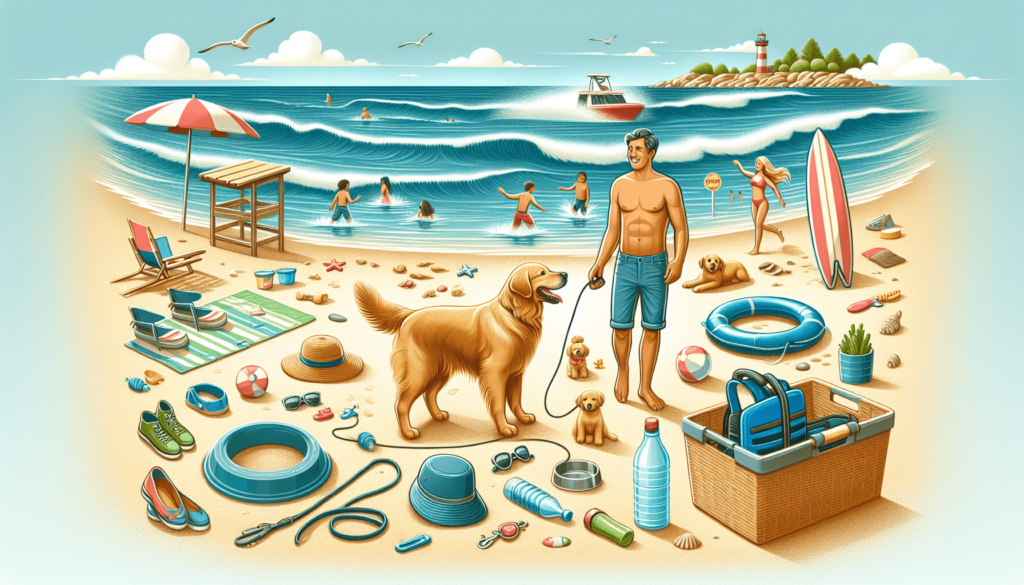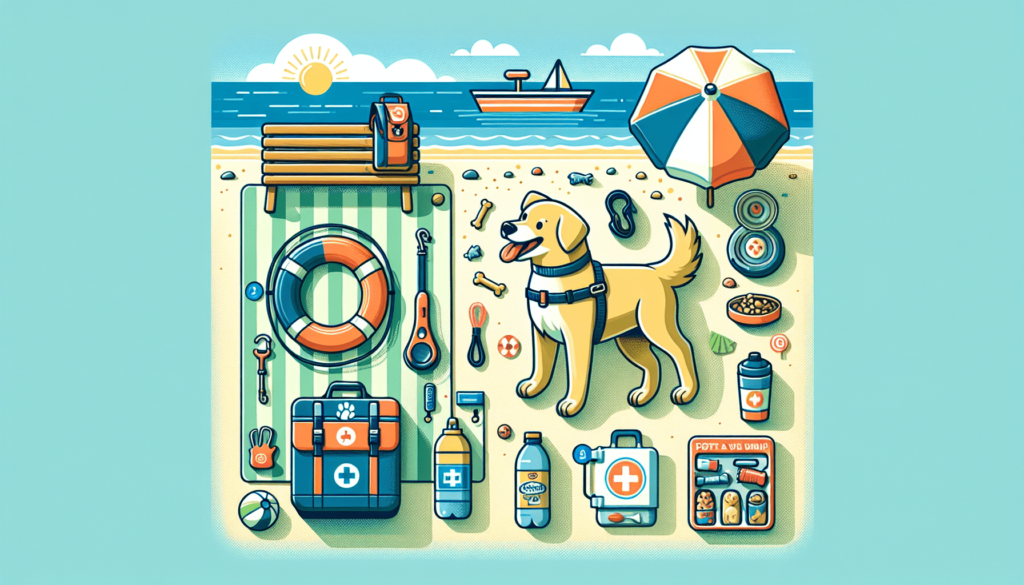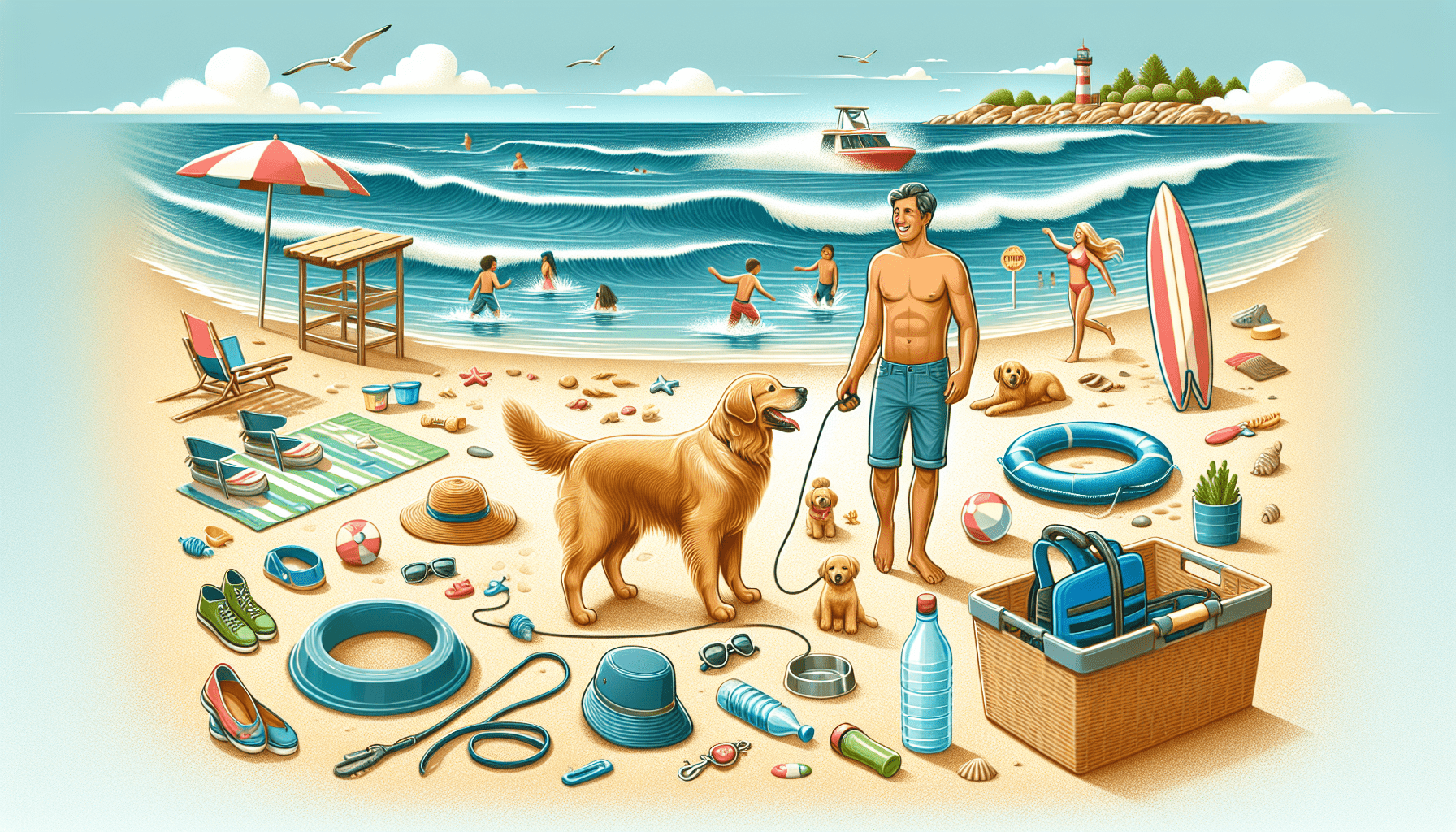Imagine spending a sunny day at the beach, with your furry best friend in tow, frolicking in the waves and chasing seagulls. Sounds like a dream, right? Well, this article is here to help you turn that dream into reality! Whether you’re a seasoned beachgoer or planning your dog’s first beach adventure, our Guide to Safe and Fun Beach Days with Your Dog has got you covered. From essential safety tips to fun activities to keep your pup entertained, this guide will ensure that both you and your four-legged companion have a beach day to remember. So grab your sunscreen, pack a towel, and get ready to embark on an unforgettable seaside excursion with your pup!

Choosing a Dog-Friendly Beach
When planning a beach outing with your furry friend, it’s important to choose a dog-friendly beach. Researching various beaches in your area will help you find ones that allow dogs. Look for beaches with designated dog areas or beaches that have lenient rules when it comes to pets.
Before heading to the beach, check the specific rules and regulations of the beach you plan to visit. Some beaches have restrictions on dogs, such as requiring them to be on a leash at all times or having specific hours when dogs are allowed. Understanding and following these rules will ensure a positive experience for both you and your dog.
In addition to checking the rules, it’s crucial to consider safety factors. Look for beaches with calm waters and gentle currents, especially if your dog is not a strong swimmer. Steer clear of beaches with strong undertows or dangerous tides, as these can put your dog at risk. It’s also important to assess the beach for any potential hazards, such as sharp objects or poisonous marine life.
Preparing Your Dog for the Beach
Before heading to the beach, it’s essential to ensure your dog’s health and well-being. Schedule a check-up with your veterinarian to make sure your dog is in good physical condition. The veterinarian can also provide you with information on any health concerns specific to your dog’s breed or age.
Training your dog for beach outings is another crucial step. Teach basic commands like “come” and “stay” to ensure your dog’s safety. Practice walking on a leash to ensure their obedience and control around other people and dogs. Training your dog to have good manners and behave appropriately will enhance the beach experience for everyone involved.
Additionally, check if your dog’s vaccinations are up to date. Some beaches require proof of vaccination, especially for diseases like rabies. Keeping your dog’s vaccinations current not only adheres to beach regulations but also protects your dog from potential health risks.
Packing Essential Beach Supplies
To ensure a comfortable and enjoyable time at the beach with your dog, it’s important to pack essential supplies. One of the most crucial items is a leash and collar. Even if the beach allows off-leash activities, having a leash handy is always a good idea for safety and control. A sturdy collar with identification tags is also necessary in case your dog happens to wander off.
Don’t forget to pack water and food bowls for your dog. Keeping your dog hydrated is essential, especially on hot beach days. Bring enough fresh water to keep your dog hydrated throughout the day. Food bowls are also necessary if you plan on having a picnic or enjoying some snacks with your dog.
Just like humans, dogs can get sunburned too. Protect your dog’s skin with dog-friendly sunscreen. Apply it to exposed areas such as the nose, ears, and belly to prevent painful sunburns. Be sure to choose a sunscreen specifically formulated for dogs, as human sunscreen can be toxic to pets.
Towels and blankets are also essential for a beach outing. Your dog will appreciate having a comfortable place to lie down, as well as something to dry off with after a swim. Pack extra towels to wipe off sand and dirt, both from your dog and yourself.
Don’t forget to bring doggy waste bags to clean up after your dog. Keeping the beach clean is not only respectful to others but also helps maintain a safe and healthy environment for everyone. Remember to dispose of waste properly in designated trash bins.
Lastly, pack some toys and treats to keep your dog entertained. Dogs love playing and exploring, so providing them with toys will help them stay engaged and active. Treats can be used as rewards for good behavior and can make the beach experience even more enjoyable for your furry friend.
Water Safety for Your Dog
Introducing your dog to the water in a gradual and positive manner is essential. Not all dogs are natural swimmers, so take it slow and let your dog get comfortable with the water at their own pace. Start in shallow water and use positive reinforcement to encourage your dog. If your dog shows signs of anxiety or discomfort, don’t force them into the water.
Using a life jacket for dogs is an extra precaution to ensure their safety in the water. Even if your dog is a strong swimmer, a life jacket provides an extra layer of protection. Choose a life jacket that properly fits your dog and has a handle on the back for easy rescue if necessary.
While your dog is in the water, it’s crucial to monitor their swimming behavior closely. Keep an eye out for signs of exhaustion or distress, such as excessive panting or struggling to stay afloat. If your dog appears tired, it’s time to take a break and let them rest.
Be aware of the currents and tides at the beach you’re visiting. Strong currents can pose a risk to both you and your dog. Avoid areas with rough waters or rip currents, as these can be dangerous, especially for inexperienced swimmers. Always err on the side of caution and prioritize your dog’s safety.

Avoiding Heat-Related Issues
Providing shade and shelter for your dog is essential to prevent heat-related issues. Dogs are susceptible to heatstroke and dehydration, so it’s crucial to create a cool and shaded area for them. Use an umbrella or set up a canopy to offer protection from the sun’s rays. Always ensure there is an area where your dog can rest comfortably and escape the heat.
Hydrating your dog is key to preventing heat exhaustion. Bring plenty of fresh water and offer it to your dog frequently throughout the day. Encourage your dog to drink and monitor their water intake to ensure they stay hydrated. Avoid giving them ocean water, as it can be harmful to their health.
Recognizing signs of heat exhaustion is essential for your dog’s well-being. Symptoms may include excessive panting, drooling, weakness, vomiting, or collapse. If you notice any of these signs, move your dog to a cool and shaded area immediately. Offer water and wet their paws and belly with a damp towel to help lower their body temperature. If the symptoms persist or worsen, seek veterinary care immediately.
Avoiding peak sun hours is another way to protect your dog from heat-related issues. The sun’s rays are strongest between 10 am and 4 pm, so plan your beach outings accordingly. Opt for early morning or late afternoon visits when the temperatures are cooler. This will help prevent your dog from overheating and minimize the risk of sunburn.
Keeping Your Dog Safe from Marine Hazards
When taking your dog to the beach, it’s important to be cautious of jellyfish and other sea creatures. Some jellyfish can have a painful sting that can be harmful to dogs. Keep an eye out for any marine animals in the water or washed up on the shore. If you spot any jellyfish or other potentially dangerous creatures, steer clear and keep your dog away from them.
Preventing ingestion of harmful substances is crucial to your dog’s safety. Some marine life, like certain species of fish or plants, can be toxic if ingested. Train your dog not to scavenge or eat things they find on the beach. It’s also important to discourage your dog from drinking seawater, as it can lead to dehydration and other health issues.
Contact with sharp objects on the beach can cause injuries to your dog’s paws or body. Be cautious of broken glass, shells, or other debris that can pose a threat. When walking your dog on the beach, keep them on a leash and avoid areas with visible hazards. Regularly inspect your dog’s paws for any cuts or punctures and seek veterinary attention if needed.
Dogs are prone to ear infections, and the beach environment can increase the risk. Addressing potential ear infections is important to keep your dog comfortable and healthy. After your dog has been in the water, gently dry their ears with a towel or use a dedicated ear drying solution for dogs. It’s also a good idea to check their ears regularly and seek veterinary care if you notice any signs of infection, such as redness, discharge, or a foul odor.
Safeguarding against Beach Toxins
To ensure your dog’s safety at the beach, it’s important to avoid toxic plants that may be present. Some plants, like certain types of seaweed or beach grass, can be harmful if ingested. Keep an eye on your dog and discourage them from nibbling on plants. If you notice any unusual behavior or symptoms after your beach visit, contact your veterinarian immediately.
Protecting against sand fleas and ticks is crucial to prevent itching and potential diseases. Apply a dog-friendly flea and tick preventative before heading to the beach. Check your dog for any signs of fleas or ticks after your visit and promptly remove them if found. Regularly grooming and bathing your dog can also help prevent infestations.
Rinsing off saltwater and sand after a beach visit is important to keep your dog clean and comfortable. Use fresh water to thoroughly rinse your dog’s fur, paying attention to paws and underbelly, where sand can accumulate. Leaving saltwater or sand on your dog’s fur can cause irritation and discomfort.
Preventing sand ingestion is important as it can cause digestive issues and discomfort. Keep a close eye on your dog and discourage them from eating sand. Provide toys and treats as alternative distractions to prevent them from ingesting sand unintentionally.
Etiquette and Consideration for Others
Respecting others at the beach is important to ensure a positive experience for everyone. Leashing your dog when necessary is essential, especially in areas where dogs are required to be on a leash. Even if your dog is well-behaved off-leash, it’s important to consider others who may be uncomfortable or have dogs that are not friendly.
Cleaning up after your dog is not only a courteous gesture but also a responsibility. Always bring doggy waste bags and promptly pick up after your dog. Dispose of the waste properly in designated trash bins to keep the beach clean and safe for everyone to enjoy.
Respecting others’ space and comfort is crucial at the beach. Some people may have allergies or anxieties around dogs, so be mindful of their boundaries. Avoid allowing your dog to approach strangers without their permission. Following these guidelines will help create a positive and inclusive beach environment for all.
Minimizing noise and disturbances is important to respect the beach’s peaceful atmosphere. Loud barking or excessive noise can be disruptive to others trying to relax. Keep your dog’s excitement in check and encourage them to play and interact without causing disturbances. Remember, a quiet and calm beach experience is enjoyable for everyone.
Entertaining and Exercising Your Dog on the Beach
Beach outings provide an excellent opportunity for fun and exercise with your dog. Playing fetch or frisbee is a classic beach pastime that dogs love. Find an open area away from others and engage in a game of fetch or frisbee with your furry friend. It’s a great way to tire them out and keep them mentally stimulated.
Swimming and water activities are a fantastic way to cool off and have fun at the beach. If your dog enjoys the water, let them swim and splash around under your supervision. Throw a floating toy or ball into the water to encourage them to swim and retrieve it. Always monitor their swimming behavior to ensure their safety.
Exploring the beach on leash is another way to entertain and exercise your dog. Take leisurely walks along the shoreline or let them sniff and explore the beach’s surroundings. Walking on sand provides a unique workout for your dog’s muscles and is a great way to burn off energy.
Rewarding your dog with treats and praise is essential during beach activities. Positive reinforcement encourages good behavior and strengthens your bond with your dog. Bring along their favorite treats to reward them for listening to commands or performing tricks. Don’t forget to shower them with praise and affection for a job well done.
After the Beach
After a fun-filled day at the beach, it’s important to take care of your dog’s well-being. Rinse off and dry your dog to remove any remaining sand or saltwater. This will keep their skin and coat clean and prevent irritation.
Checking for ticks or fleas is crucial to catch any potential infestations early on. Inspect your dog’s fur thoroughly, paying close attention to areas where ticks commonly hide, such as behind the ears and between the toes. Remove any ticks found promptly and consult with your veterinarian if necessary.
Offering fresh water and food to your dog after the beach is important for rehydration and nutrition. Make sure they have access to clean, fresh water and provide a small meal to replenish their energy.
Monitoring for post-beach health issues is essential. Keep an eye out for any signs of sunburn, skin irritation, or other health concerns that may have developed during the beach outing. If you notice any unusual symptoms, contact your veterinarian for guidance and treatment.
In conclusion, beach days with your dog can be safe and enjoyable with proper preparation and precautions. By choosing a dog-friendly beach, preparing your dog for the outing, packing essential supplies, ensuring water safety, avoiding heat-related issues, safeguarding against marine hazards and toxins, practicing etiquette and consideration for others, entertaining and exercising your dog, and taking care of them after the beach, you can create fun-filled memories while keeping your dog’s well-being as a top priority. So grab your sunscreen, a beach towel, and your four-legged friend, and get ready for a pawsome day at the beach!

